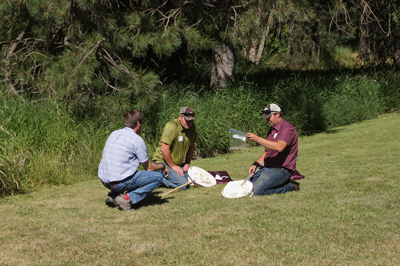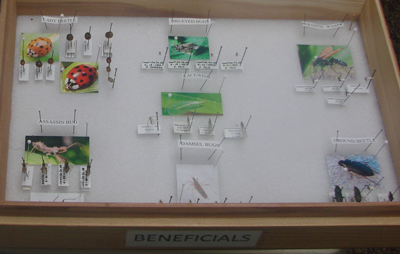IPM Training Program Targets Young Ag Professionals in the Pacific Northwest
 In the ancient Chinese military treatise “The Art of War,” the first principle for victory is to know your enemy.
In the ancient Chinese military treatise “The Art of War,” the first principle for victory is to know your enemy.
For farmers in the West, that advice still holds true.
To manage pests, growers have to be able to identify them. They have to be able to recognize enemies – insects, weeds and diseases that will cause them economic harm – and realize that not all bugs or blotches on their plants are enemies. Some are allies – beneficial insects that prey on damaging pest – and others are Swiss, neutral third parties that neither help nor harm the growers’ crops.
Identification of pests and beneficials is one of the first principles of integrated pest management, and the core of a train-the-trainers program that’s been successfully improving the skills of young ag professionals in rural Oregon, Washington and Idaho since 2009.
“We’ve targeted the ag industry, because a lot of people in the industry now are very young,” explained Steve Van Vleet, an extension specialist with Washington State University in Colfax and one of the project’s trainers. “A lot of the old guard is retiring and has been replaced by young men and women.”
The trainees are primarily crop consultants who work with a number of different growers, or area managers for the big farming companies growing irrigated or dryland crops in the Columbia River Basin and surrounding areas of eastern Oregon and Washington and western Idaho.
The program received its first funding in 2009, and includes extension specialists from Oregon State University and the University of Idaho as well as Washington State University. In classes limited to 20 participants at a time, the program has trained 140 people to date.
 “The first program was focused just on insects,” said Silvia Rodon, an extension entomologist at Oregon State University’s Hermiston Agriculture Research and Extension Center. “We taught them how to collect and identify insects, and sent them home with all the supplies they would need to begin their own collections – sweep nets, killing jars, tweezers, pinning boards to mount insects. Based on the success of that experience, we added plant pathology – diseases – and a weed course to the training.”
“The first program was focused just on insects,” said Silvia Rodon, an extension entomologist at Oregon State University’s Hermiston Agriculture Research and Extension Center. “We taught them how to collect and identify insects, and sent them home with all the supplies they would need to begin their own collections – sweep nets, killing jars, tweezers, pinning boards to mount insects. Based on the success of that experience, we added plant pathology – diseases – and a weed course to the training.”
The workshop now extends over three full days, with one day devoted to plant diseases, one to insects and one to weeds.
“Integrated pest management is the recurring theme throughout the program,” said Mary Corp, the director of Oregon State’s Columbia Basin Ag Research Center in Pendleton. “A lot of people who take the training know the words, but we want them to understand IPM principles and practices. We want them to be able to put it into practice.”
One of those IPM practices is scouting fields for pests and beneficials, and using thresholds established by university research programs to decide whether or not to spray a pesticide. If there are enough of the right kinds of beneficial insects, spraying can do more harm than good.
But making that decision is not necessarily easy, especially for newer crop consultants and farm managers who don’t have a long track record with the farmers they advise.
“Because they are such a young audience of crop consultants, they feel a lot of pressure to make a decision,” Corp explained. “One of the hardest things for a farmer to do is nothing, so these young crop consultants are under a lot of pressure to make a recommendation. Our program tells them ‘Don’t skip the steps. Don’t sacrifice good decision-making.’”
Attendees are required to provide 10 hours of training to others, and Rondon said most go well beyond that in spreading the information they’ve gained to others in their communities or companies.
And it’s working. Van Vleet estimated that 15 to 25 percent of trainees are adopting integrated pest management principles into their farming practices, and training others in their companies in IPM as well.
“That’s why we do the train-the-trainer program,” he said. “So they train others so they also know not just the terminology of IPM, but understand the principles and practices.”
And the first IPM practice that’s being implemented? Identification. All three universities have seen increases in the number of submission to their diagnostic labs from the people they’ve trained and the people those trainees are advising.
The growers in the Columbia River Basin are making sure to know their enemy.